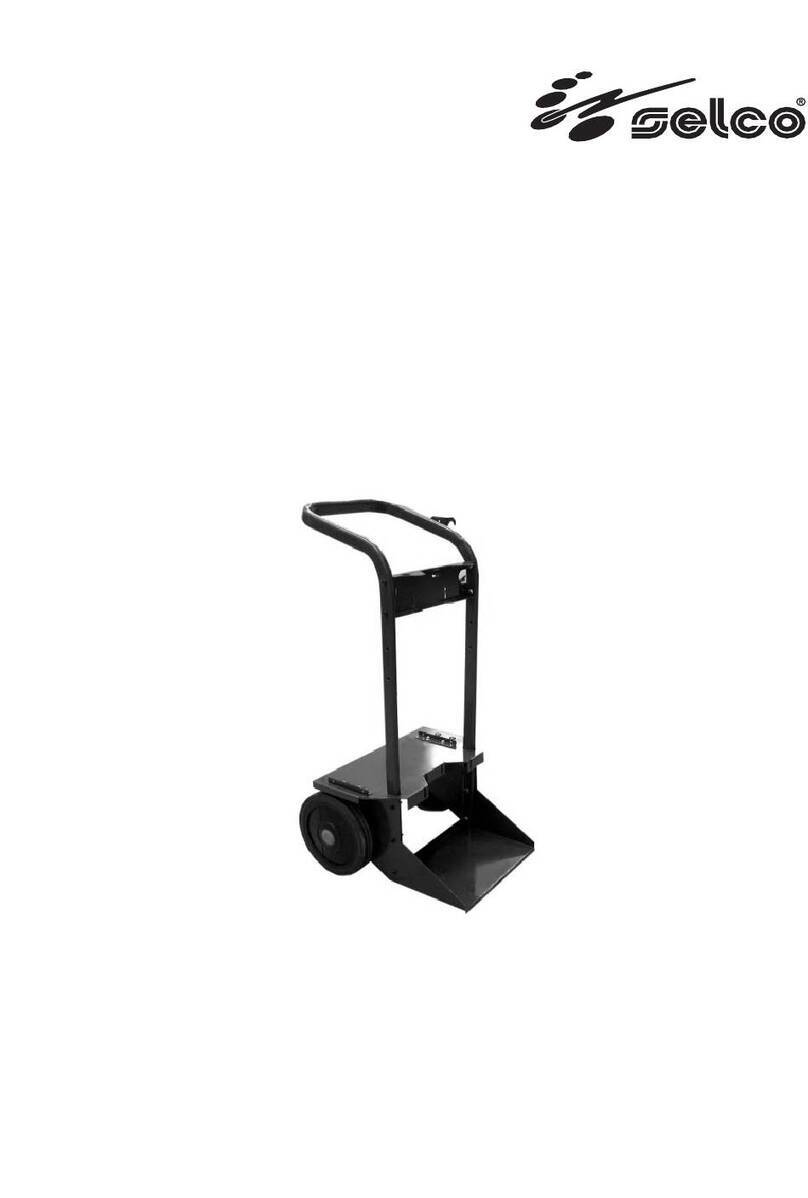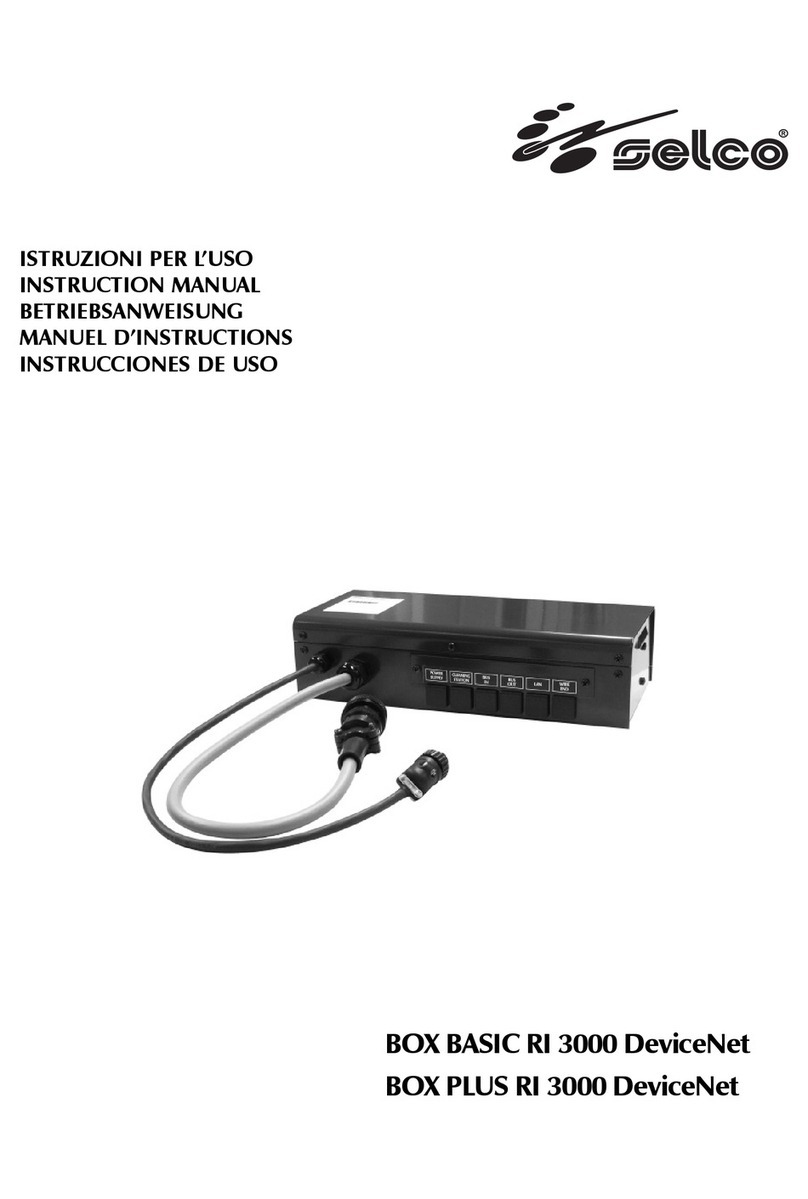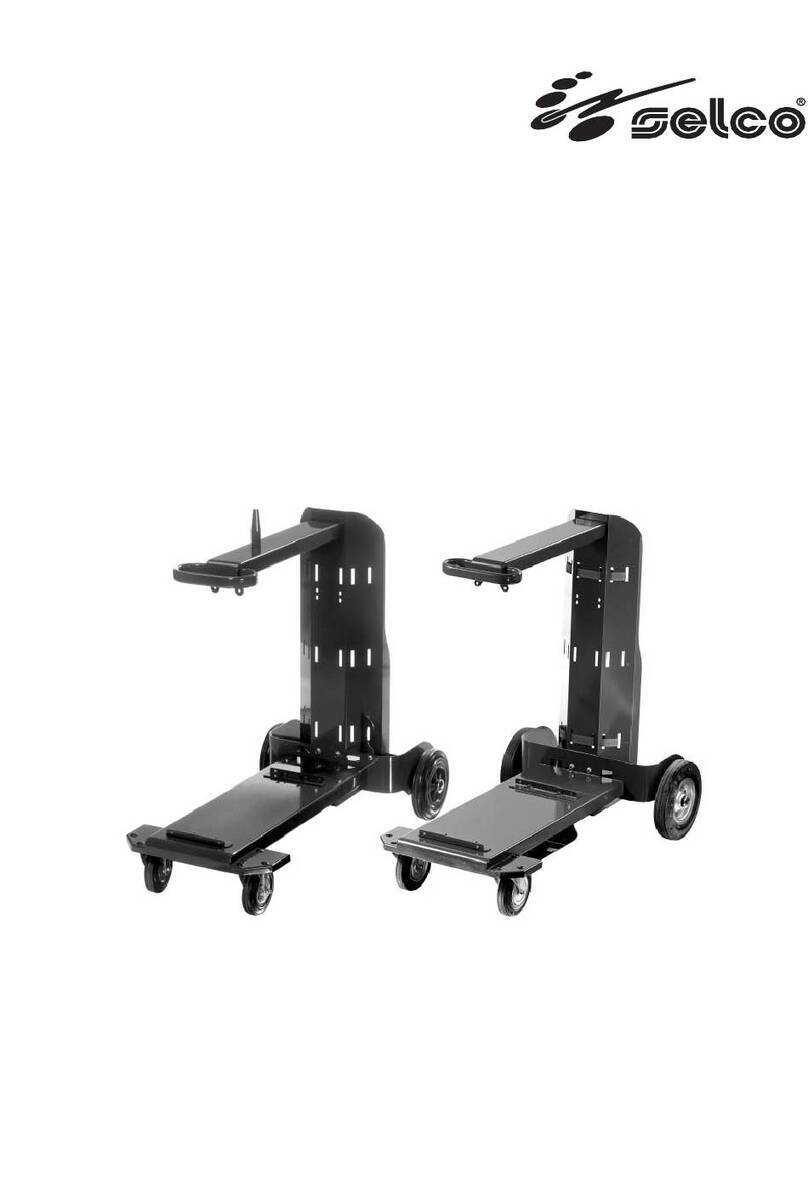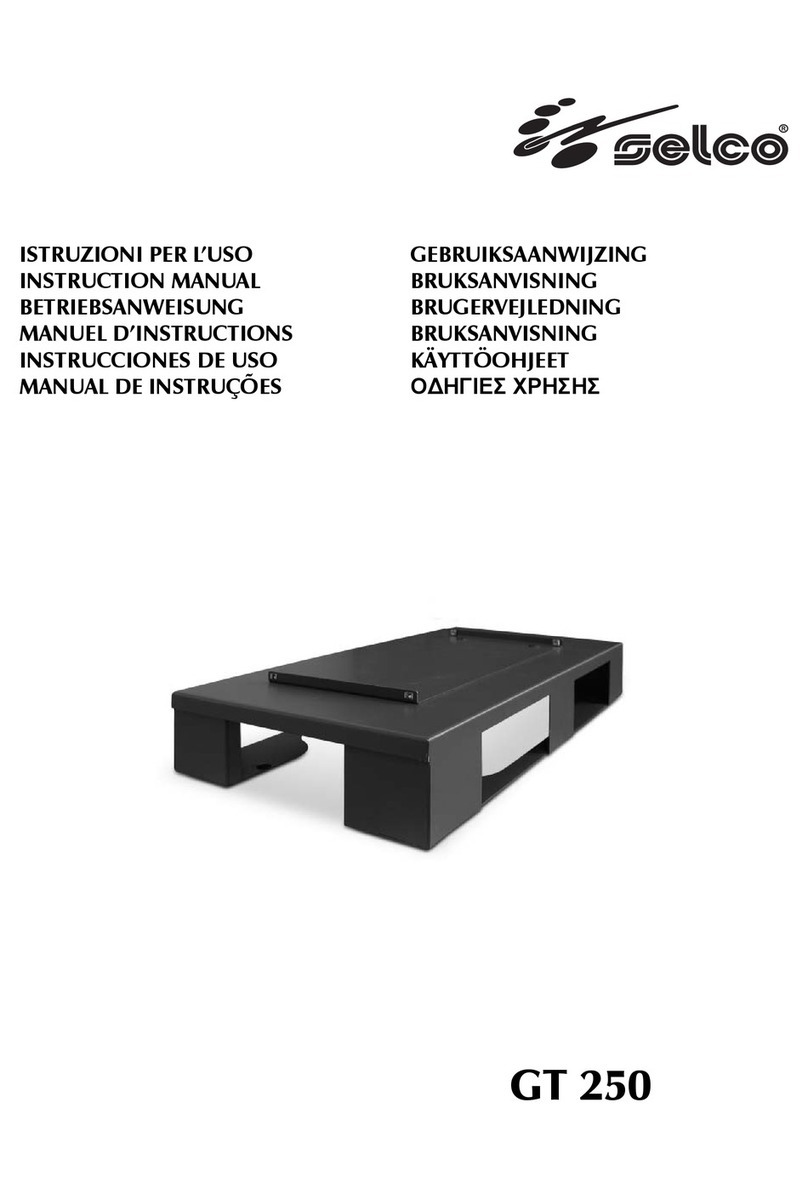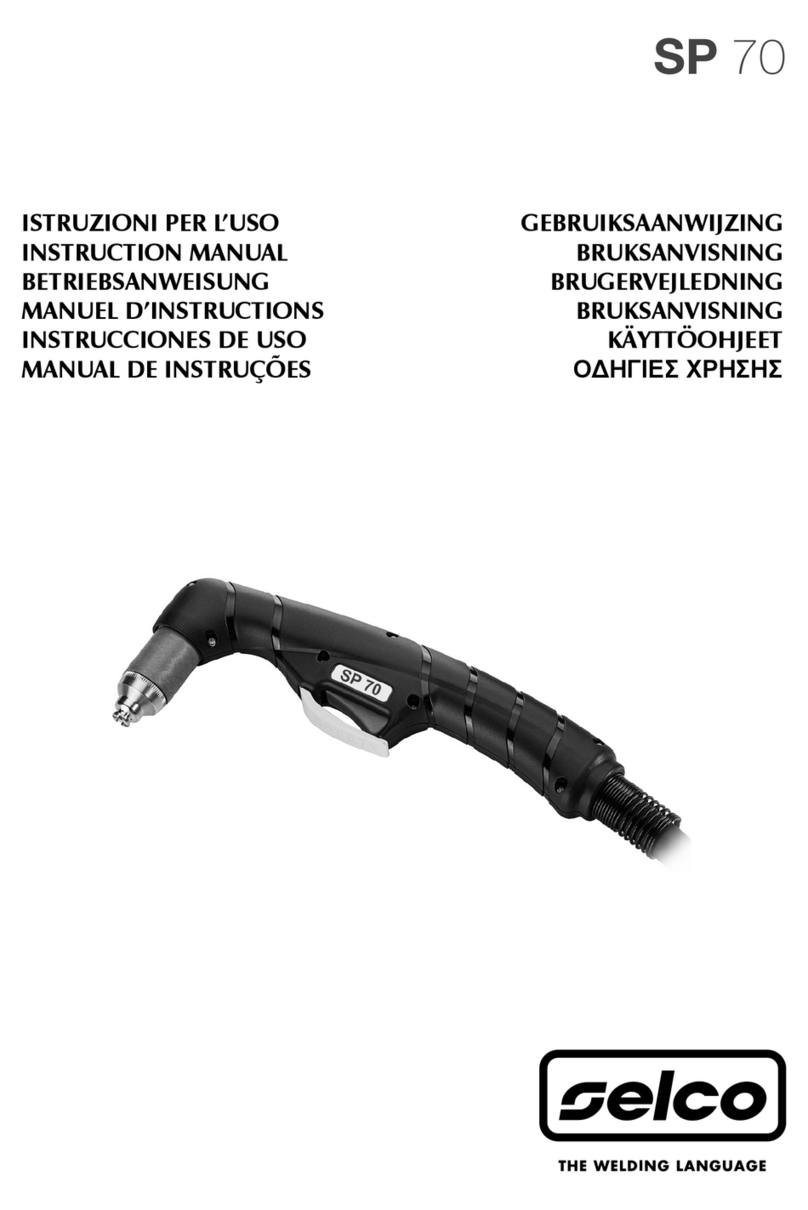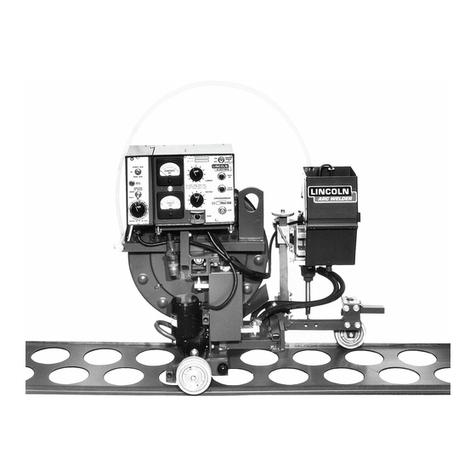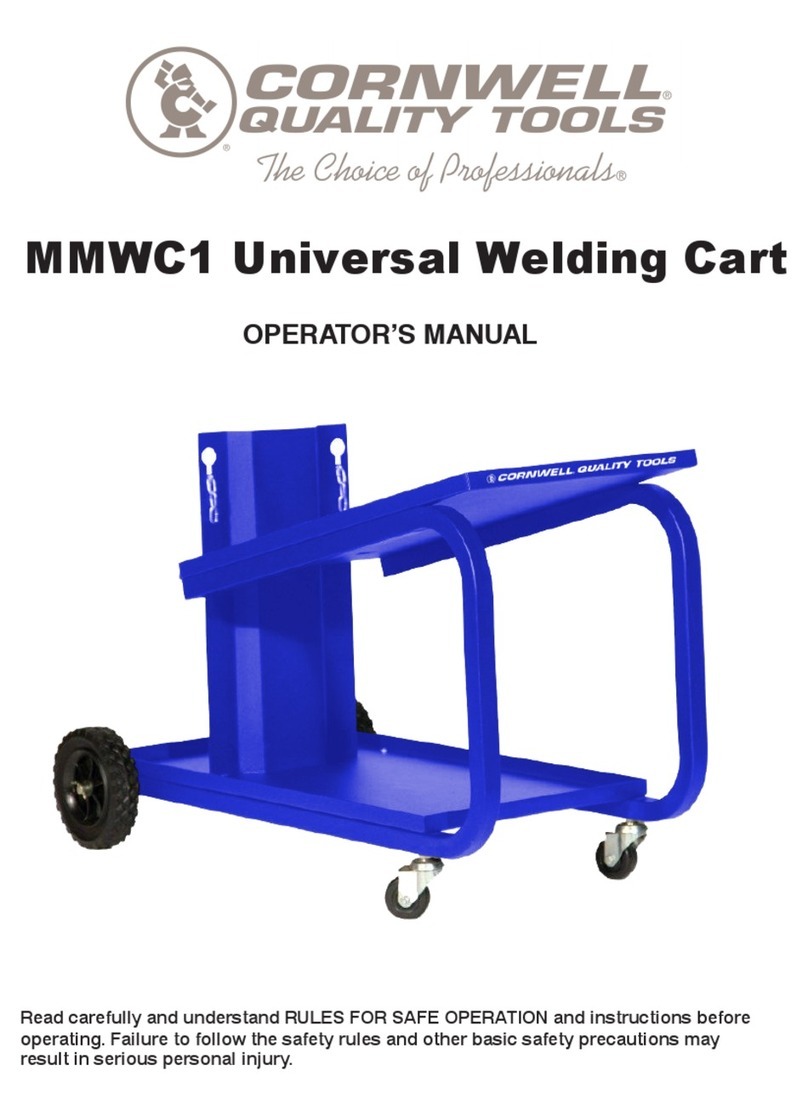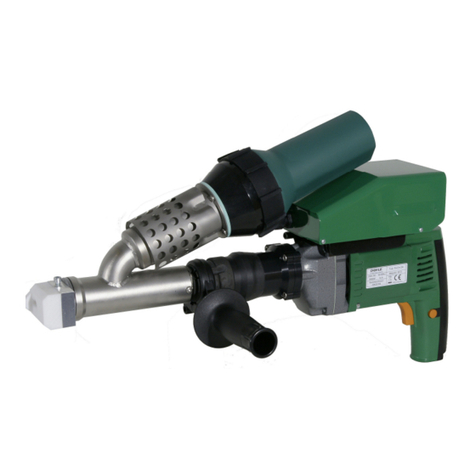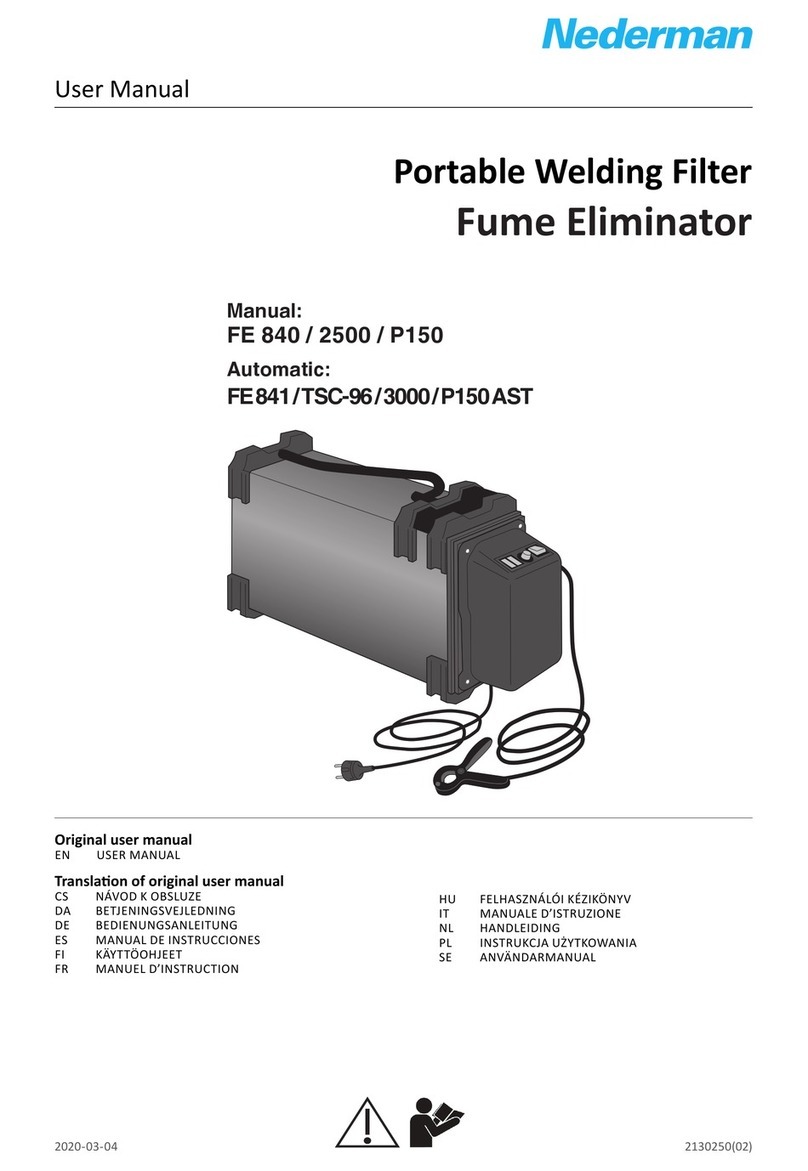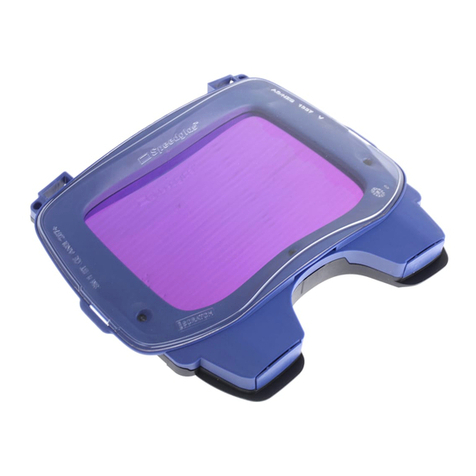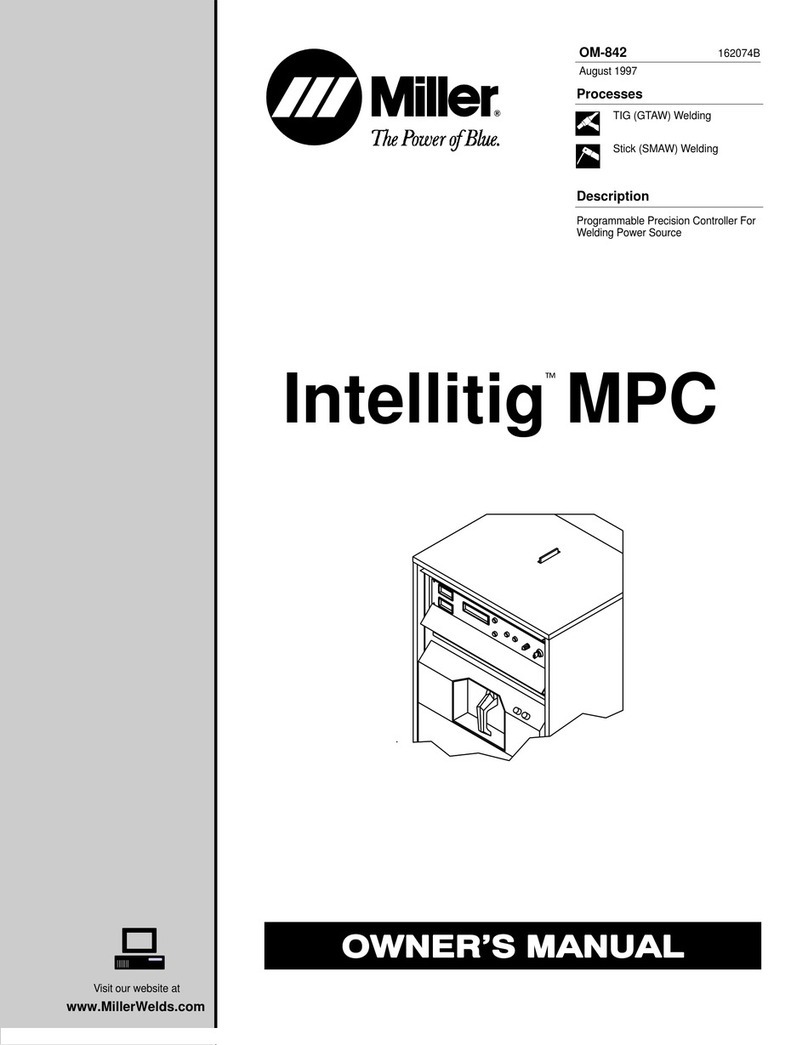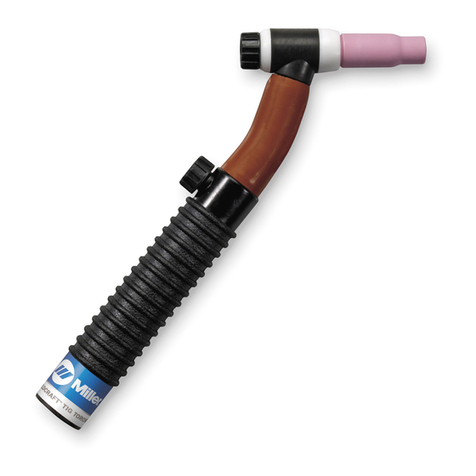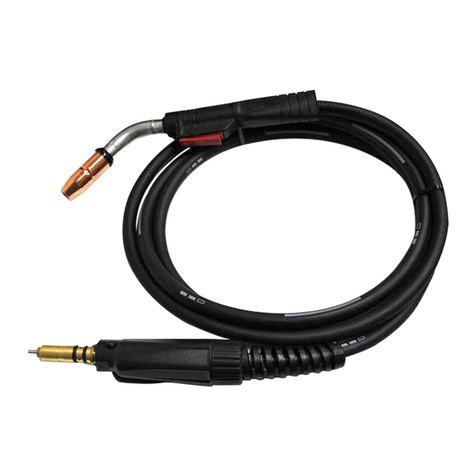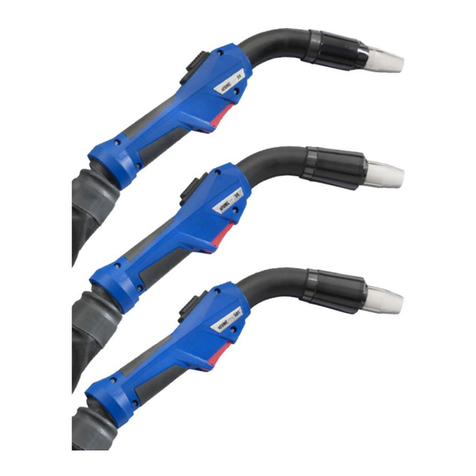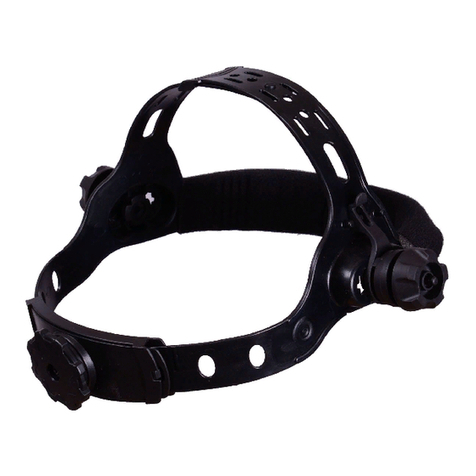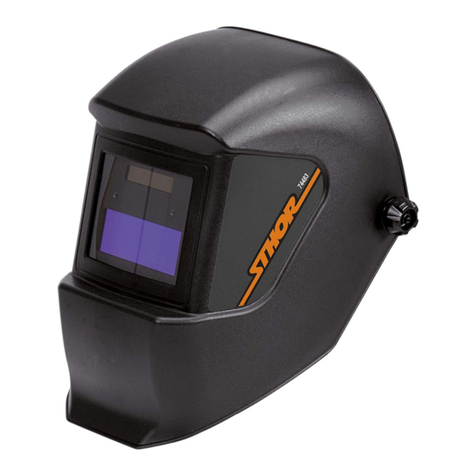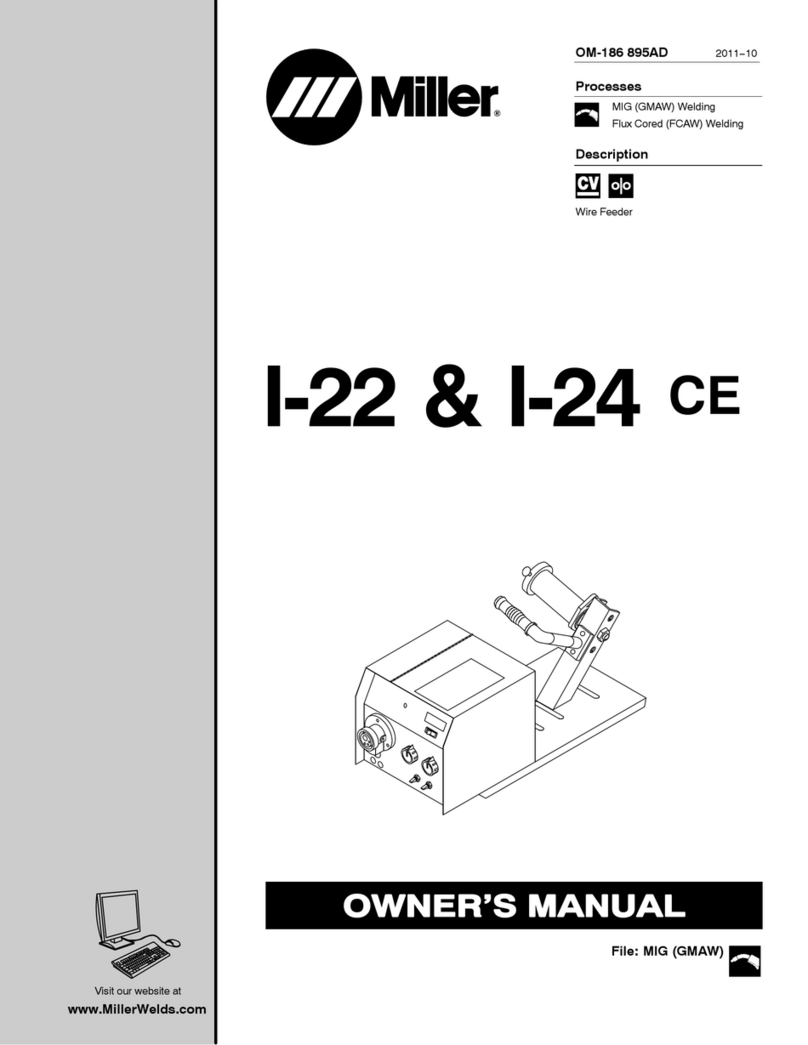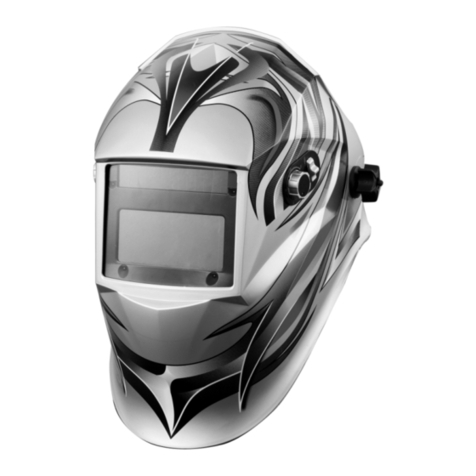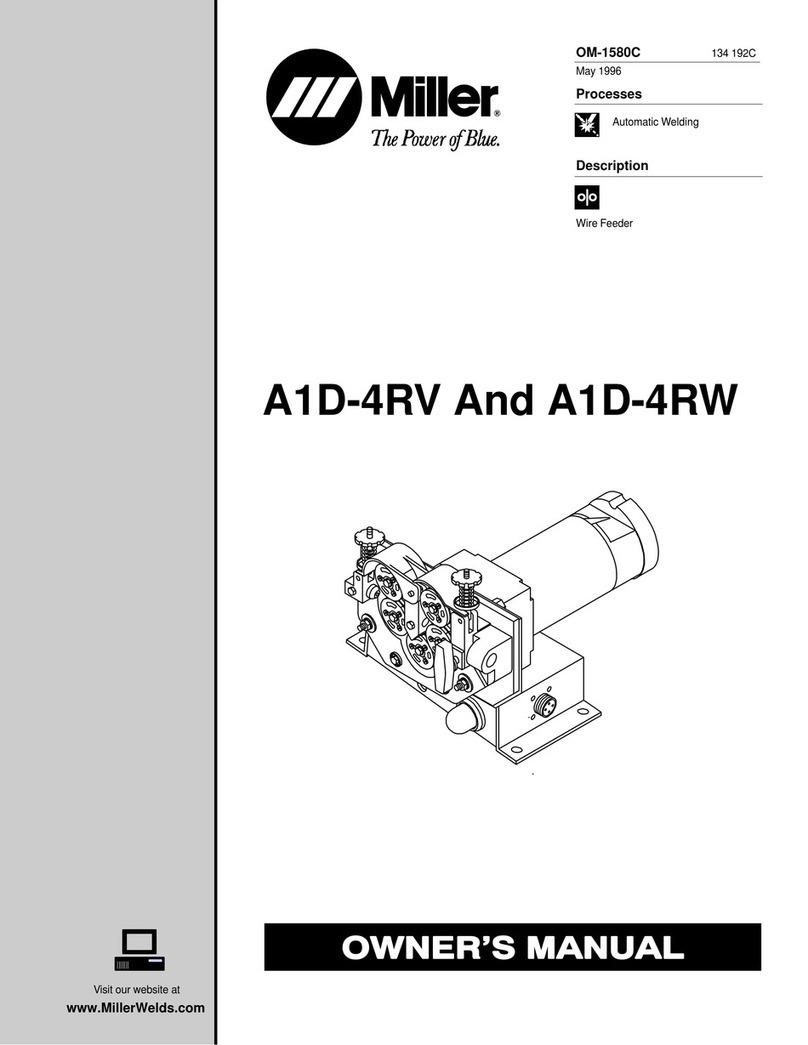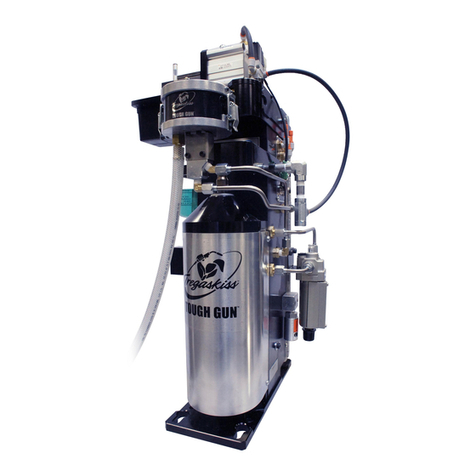Sel WFR 1000 SYNCRO User manual

WFR 1000 SYNCRO
ISTRUZIONI PER L’USO
INSTRUCTION MANUAL
BETRIEBSANWEISUNG
MANUEL D’INSTRUCTIONS
INSTRUCCIONES DE USO
MANUAL DE INSTRUÇÕES
GEBRUIKSAANWIJZING
BRUKSANVISNING
BRUGERVEJLEDNING
BRUKSANVISNING
KÄYTTÖOHJEET
OΔΗΓΙΕΣ ΧΡΗΣΗΣ

Cod. 91.08.256
Data 21/12/2016
Rev.
ITALIANO ................................................................................................................................................................................3
ENGLISH................................................................................................................................................................................11
DEUTSCH..............................................................................................................................................................................19
FRANÇAIS..............................................................................................................................................................................27
ESPAÑOL ...............................................................................................................................................................................35
PORTUGUÊS .........................................................................................................................................................................43
NEDERLANDS........................................................................................................................................................................51
SVENSKA................................................................................................................................................................................59
DANSK...................................................................................................................................................................................67
NORSK...................................................................................................................................................................................75
SUOMI ..................................................................................................................................................................................83
ΕΛΛHNIKA............................................................................................................................................................................91
6 Targa dati, Rating plate, Leistungschilder, Plaque données, Placa de características, Placa de dados, Technische gege-
vens, Märkplåt, Dataskilt, Identifikasjonsplate, Arvokilpi, πινακιδα χαρακτηριστικων............................................. 99
7 Significato targa dati, Meaning of rating plate, Bedeutung der Angaben auf dem Leistungsschild, Signification de la
plaque des données, Significado de la etiqueta de los datos, Significado da placa de dados, Betekenis gegevensplaatje,
Märkplåt, Betydning af oplysningerne på dataskilt, Beskrivelse av informasjonsskilt, Kilven sisältö, σημασία πινακίδας
χαρ ακτηριότικών ........................................................................................................................................................100
8 Schema,Diagram,Schaltplan,Schéma,Esquema,Diagrama,Schema,kopplingsschema,Oversigt,Skjema,Kytkentäkaavio,
διαγραμμα ................................................................................................................................................................. 101
9 Connettori, Connectors, Verbinder, Connecteurs, Conectores, Conectores, Verbindingen, Kontaktdon, Konnektorer,
Skjøtemunnstykker, Liittimet, ςυνδετηρεσ................................................................................................................. 102
10 Cavo di collegamento, ...........................................Connection cable, Verbindungskabel, Câble de branchement, Cable
de conexión, Cabo de ligação, verbindingskabel, Anslutningskabel, Tilslutningskabel, Koplingskabel , Liitäntäkaapeli ,
καλώδιο σύνδεσης......................................................................................................................................................103
11 Lista ricambi, Spare parts list, Ersatzteilverzeichnis, Liste de pièces détachées, Lista de repuestos, Lista de peças de
reposição, Lijst van reserve onderdelen, Reservdelslista, Reservedelsliste, Liste over reservedeler, Varaosaluettelo,
καταλογοσ ανταλλακτικων ...................................................................................................................................... 104

ITALIANO
Ringraziamenti...
Vi ringraziamo della fiducia accordataci nell’aver scelto la QUALITA’, la TECNOLOGIA e l’AFFIDABILITA’ dei prodotti SELCO.
Per sfruttare le potenzialità e le caratteristiche del prodotto acquistato, vi invitiamo a leggere attentamente le seguenti istruzioni che
vi aiuteranno a conoscere al meglio il prodotto e ad ottenere i migliori risultati.
Prima di iniziare qualsiasi operazione siate sicuri di aver ben letto e compreso questo manuale. Non apportate modifiche e non ese-
guite manutenzioni non descritte. Per ogni dubbio o problema circa l’utilizzo della macchina, anche se qui non descritto, consultare
personale qualificato.
Questo manuale è parte integrante della unità o macchina e deve accompagnarla in ogni suo spostamento o rivendita.
È cura dell’utilizzatore mantenerlo integro ed in buone condizioni.
La SELCO s.r.l. si riserva il diritto di apportare modifiche in qualsiasi momento e senza alcun preavviso.
I diritti di traduzione, di riproduzione e di adattamento, totale o parziale e con qualsiasi mezzo (compresi le copie fotostatiche, i film
ed i microfilm) sono riservati e vietati senza l’autorizzazione scritta della SELCO s.r.l.
Quanto esposto è di vitale importanza e pertanto necessario affinchè le garanzie possano operare.
Nel caso l’operatore non si attenesse a quanto descritto, il costruttore declina ogni responsabilità.
DICHIARAZIONE DI CONFORMITA’ CE
La ditta
SELCO s.r.l. - Via Palladio, 19 - 35019 ONARA DI TOMBOLO (Padova) - ITALY
dichiara che l'apparecchio tipo WFR 1000 SYNCRO
è conforme alle direttive EU: 2014/35/EU LOW VOLTAGE DIRECTIVE
2014/30/EU EMC DIRECTIVE
2011/65/EU RoHS DIRECTIVE
e che sono state applicate le norme: EN 60974-5
EN 60974-10 Class A
Ogni intervento o modifica non autorizzati dalla SELCO s.r.l. faranno decadere la validità di questa dichiarazione.
Onara di Tombolo (PADOVA) Selco s.r.l.
Lino Frasson
Chief Executive
3

4
INDICE
SIMBOLOGIA
Pericoli imminenti che causano gravi lesioni e comportamenti rischiosi che potrebbero causare gravi lesioni
Comportamenti che potrebbero causare lesioni non gravi o danni alle cose
Le note precedute da questo simbolo sono di carattere tecnico e facilitano le operazioni
1 AVVERTENZE .................................................................................................................................................5
1.1 Ambiente di utilizzo...............................................................................................................................5
1.2 Protezione personale e di terzi...............................................................................................................5
1.3 Protezione da fumi e gas .......................................................................................................................6
1.4 Prevenzione incendio/scoppio ...............................................................................................................6
1.5 Prevenzione nell’uso delle bombole di gas.............................................................................................6
1.6 Protezione da shock elettrico.................................................................................................................6
1.7 Campi elettromagnetici ed interferenze .................................................................................................7
1.8 Grado di protezione IP ..........................................................................................................................8
2 INSTALLAZIONE ............................................................................................................................................8
2.1 Modalità di sollevamento, trasporto e scarico.........................................................................................8
2.2 Posizionamento dell’impianto ................................................................................................................8
2.3 Allacciamento........................................................................................................................................8
2.4 Messa in servizio....................................................................................................................................8
3 PRESENTAZIONE DELL’IMPIANTO ................................................................................................................9
3.1 Pannello comandi .................................................................................................................................9
3.2 Pannello frontale ...................................................................................................................................9
3.3 Pannello posteriore ...............................................................................................................................9
4 MANUTENZIONE .......................................................................................................................................10
5 CARATTERISTICHE TECNICHE.....................................................................................................................10

5
1 AVVERTENZE
Prima di iniziare qualsiasi operazione siate sicuri di
aver ben letto e compreso questo manuale.
Non apportate modifiche e non eseguite manuten-
zioni non descritte.
Il produttore non si fa carico di danni a persone o cose, occorsi
per incuria nella lettura o nella messa in pratica di quanto scritto
in questo manuale.
Per ogni dubbio o problema circa l’utilizzo dell’im-
pianto, anche se qui non descritto, consultare per-
sonale qualificato.
1.1 Ambiente di utilizzo
• Ogni impianto deve essere utilizzato esclusivamente per le
operazioni per cui è stato progettato, nei modi e nei campi
previsti in targa dati e/o in questo manuale, secondo le diret-
tive nazionali e internazionali relative alla sicurezza.
Un utilizzo diverso da quello espressamente dichiarato dal
costruttore è da considerarsi totalmente inappropriato e peri-
coloso e in tal caso il costruttore declina ogni responsabilità.
• Questo apparecchio deve essere usato solo a scopo professio-
nale in un ambiente industriale.
Il costruttore non risponderà di danni provocati dall'uso del-
l'impianto in ambienti domestici.
• L'impianto deve essere utilizzato in ambienti con temperatura
compresa tra i -10°C e i +40°C (tra i +14°F e i +104°F).
L'impianto deve essere trasportato e immagazzinato in
ambienti con temperatura compresa tra i -25°C e i +55°C (tra
i -13°F e i 131°F).
• L'impianto deve essere utilizzato in ambienti privi di polvere,
acidi, gas o altre sostanze corrosive.
• L'impianto deve essere utilizzato in ambienti con umidità relati-
va non superiore al 50% a 40°C (104°F).
L'impianto deve essere utilizzato in ambienti con umidità relati-
va non superiore al 90% a 20°C (68°F).
• L'impianto deve essere utilizzato ad una altitudine massima sul
livello del mare di 2000m (6500 piedi).
Non utilizzare tale apparecchiatura per scongelare
tubi.
Non utilizzare tale apparecchiatura per caricare
batterie e/o accumulatori.
Non utilizzare tale apparecchiatura per far partire
motori.
1.2 Protezione personale e di terzi
Il processo di saldatura (taglio) è fonte nociva di
radiazioni, rumore, calore ed esalazioni gassose.
Indossare indumenti di protezione per proteggere
la pelle dai raggi dell’arco e dalle scintille o dal
metallo incandescente.
Gli indumenti utilizzati devono coprire tutto il
corpo e devono essere:
- integri e in buono stato
- ignifughi
- isolanti e asciutti
- aderenti al corpo e privi di risvolti
Utilizzare sempre calzature a normativa, resistenti e
in grado di garantire l'isolamento dall'acqua.
Utilizzare sempre guanti a normativa, in grado di
garantire l'isolamento elettrico e termico.
Sistemare una parete divisoria ignifuga per proteg-
gere la zona di saldatura (taglio) da raggi, scintille e
scorie incandescenti.
Avvertire le eventuali terze persone di non fissare
con lo sguardo la saldatura (taglio) e di proteggersi
dai raggi dell’arco o del metallo incandescente.
Utilizzare maschere con protezioni laterali per il
viso e filtro di protezione idoneo (almeno NR10 o
maggiore) per gli occhi.
Indossare sempre occhiali di sicurezza con schermi
laterali specialmente nell’operazione manuale o
meccanica di rimozione delle scorie di saldatura
(taglio).
Non utilizzare lenti a contatto!!!
Utilizzare cuffie antirumore se il processo di saldatu-
ra (taglio) diviene fonte di rumorosità pericolosa.
Se il livello di rumorosità supera i limiti di legge,
delimitare la zona di lavoro ed accertarsi che le
persone che vi accedono siano protette con cuffie
o auricolari.
Evitare il contatto tra mani, capelli, indumenti,
attrezzi… e parti in movimento quali:
- ventilatori
- ruote dentate
- rulli e alberi
- bobine di filo
•Non operare sulle ruote dentate quando il trainafilo è in funzione.
•L'impianto non deve essere sottoposto ad alcun tipo di modifica.
L'esclusione dei dispositivi di protezione sulle unità di avanza-
mento del filo è estremamente pericoloso e solleva il costrut-
tore da ogni responsabilità su danni a cose e persone.
•Tenere sempre i pannelli laterali chiusi durante le operazioni
di saldatura (taglio).
Tenere la testa lontano dalla torcia MIG/MAG
durante il caricamento e l'avanzamento del filo. Il
filo in uscita può provocare seri danni alle mani, al
viso e agli occhi.
Tenere la testa lontano dalla torica PLASMA. Il flus-
so di corrente in uscita può provocare seri danni
alle mani, al viso e agli occhi.
Evitare di toccare i pezzi appena saldati (tagliati),
l'elevato calore potrebbe causare gravi ustioni o
scottature.
•Mantenere tutte le precauzioni precedentemente descritte
anche nelle lavorazioni post saldatura (taglio) in quanto, dai
pezzi lavorati che si stanno raffreddando, potrebbero staccarsi
scorie.

6
•Assicurarsi che la torcia si sia raffreddata prima di eseguire
lavorazioni o manutenzioni.
Assicurarsi che il gruppo di raffreddamento sia
spento prima di sconnettere i tubi di mandata e
ritorno del liquido refrigerante. Il liquido caldo in
uscita potrebbe causare gravi ustioni o scottature.
Provvedere ad un’attrezzatura di pronto soccorso.
Non sottovalutare scottature o ferite.
Prima di lasciare il posto di lavoro, porre in sicu-
rezza l'area di competenza in modo da impedire
danni accidentali a cose o persone.
1.3 Protezione da fumi e gas
• Fumi, gas e polveri prodotti dal processo di saldatura (taglio)
possono risultare dannosi alla salute.
I fumi prodotti durante il processo di saldatura (taglio) posso-
no, in determinate circostanze, provocare il cancro o danni al
feto nelle donne in gravidanza.
• Tenere la testa lontana dai gas e dai fumi di saldatura
(taglio).
• Prevedere una ventilazione adeguata, naturale o forzata, nella
zona di lavoro.
• In caso di aerazione insufficiente utilizzare maschere dotate
di respiratori.
• Nel caso di saldature (tagli) in ambienti angusti è consigliata
la sorveglianza dell’operatore da parte di un collega situato
esternamente.
• Non usare ossigeno per la ventilazione.
• Verificare l'efficacia dell'aspirazione controllando periodica-
mente l'entità delle emissioni di gas nocivi con i valori ammes-
si dalle norme di sicurezza.
• La quantità e la pericolosità dei fumi prodotti è riconducibile
al materiale base utilizzato, al materiale d'apporto e alle even-
tuali sostanze utilizzate per la pulizia e lo sgrassaggio dei pezzi
da saldare. Seguire attentamente le indicazioni del costruttore
e le relative schede tecniche.
• Non eseguire operazioni di saldatura (taglio) nei pressi di
luoghi di sgrassaggio o verniciatura.
Posizionare le bombole di gas in spazi aperti o con un buon
ricircolo d’aria.
1.4 Prevenzione incendio/scoppio
• Il processo di saldatura (taglio) può essere causa di incendio
e/o scoppio.
• Sgomberare dalla zona di lavoro e circostante i materiali o gli
oggetti infiammabili o combustibili.
I materiali infiammabili devono trovarsi ad almeno 11 metri
(35 piedi) dall'ambiente di saldatura o devono essere oppor-
tunamente protetti.
Le proiezioni di scintille e di particelle incandescenti possono
facilmente raggiungere le zone circostanti anche attraverso
piccole aperture. Porre particolare attenzione nella messa in
sicurezza di cose e persone.
• Non eseguire saldature (tagli) sopra o in prossimità di reci-
pienti in pressione.
• Non eseguire operazioni di saldatura o taglio su recipienti o
tubi chiusi.
Porre comunque particolare attenzione nella saldatura di tubi
o recipienti anche nel caso questi siano stati aperti, svuotati e
accuratamente puliti. Residui di gas, carburante, olio o simili
potrebbe causare esplosioni.
• Non saldare (tagliare) in atmosfera contenente polveri, gas o
vapori esplosivi.
• Accertarsi, a fine saldatura, che il circuito in tensione non
possa accidentalmente toccare parti collegate al circuito di
massa.
• Predisporre nelle vicinanze della zona di lavoro un’ attrezza-
tura o un dispositivo antincendio.
1.5 Prevenzione nell’uso delle bombo-
le di gas
• Le bombole di gas inerte contengono gas sotto pressione e
possono esplodere nel caso non vengano assicurate le condi-
zioni minime di trasporto, mantenimento e uso.
• Le bombole devono essere vincolare verticalmente a pareti o
ad altro, con mezzi idonei, per evitare cadute o urti meccani-
ci accidentali.
• Avvitare il cappuccio a protezione della valvola durante il
trasporto, la messa in servizio e ogni qualvolta le operazioni
di saldatura siano terminate.
• Evitare che le bombole siano esposte direttamente ai raggi
solari, a sbalzi elevati di temperatura, a temperature troppo
alte o troppo rigide, Non esporre le bombole a temperature
troppo rigide o troppo alte.
• Evitare che le bombole entrino in contatto con fiamme libere,
con archi elettrici, con torce o pinze porta elettrodo, con le
proiezioni incandescenti prodotte dalla saldatura.
• Tenere le bombole lontano dai circuiti di saldatura e dai cir-
cuiti di corrente in genere.
• Tenere la testa lontano dal punto di fuoriuscita del gas quando
si apre la valvola della bombola.
• Chiudere sempre la valvola della bombola quando le opera-
zioni di saldatura sono terminate.
• Non eseguire mai saldature (tagli) su una bombola di gas in
pressione.
• Non collegare mai una bombola di aria compressa diretta-
mente al riduttore della macchina!
La pressione potrebbe superare la capacità del riduttore che
quindi potrebbe esplodere!
1.6 Protezione da shock elettrico
• Uno shock da scarica elettrica può essere mortale.
• Evitare di toccare parti normalmente in tensione interne o
esterne all'impianto di saldatura/taglio mentre l'impianto stes-
so è alimentato (torce, pinze, cavi massa, elettrodi, fili, rulli e
bobine sono elettricamente collegati al circuito di saldatura).
• Assicurare l'isolamento elettrico dell'impianto e dell'operatore
di saldatura utilizzando piani e basamenti asciutti e sufficien-
temente isolati dal potenziale di terra e di massa.

• Assicurarsi che l'impianto venga allacciato correttamente ad
una spina e ad una rete provvista del conduttore di protezio-
ne a terra.
• Non toccare contemporaneamente due torce o due pinze
portaelettrodo.
Interrompere immediatamente le operazioni di saldatura
(taglio) se si avverte la sensazione di scossa elettrica.
Il dispositivo di innesco e stabilizzazione dell’arco è
progettato per il funzionamento a guida manuale o
meccanica.
L’aumento della lunghezza della torcia o dei cavi di
saldatura ad oltre 8m aumenterà il rischio di scossa
elettrica.
1.7 Campi elettromagnetici ed interferenze
•Il passaggio della corrente di saldatura attraverso i cavi interni
ed esterni all'impianto, crea un campo elettromagnetico nelle
immediate vicinanze dei cavi di saldatura e dell'impianto stesso.
•I campi elettromagnetici possono avere effetti (ad oggi scono-
sciuti) sulla salute di chi ne subisce una esposizione prolungata.
I campi elettromagnetici possono interferire con altre appa-
recchiature quali pace-maker o apparecchi acustici.
I portatori di apparecchiature elettroniche vitali
(pace-maker) devono consultare il medico prima di
avvicinarsi alle operazioni di saldatura ad arco o di
taglio al plasma.
Classificazione EMC dell’apparecchiatura in accordo con la
norma EN/IEC 60974-10 (Vedi targa dati o caratteristiche tecniche)
L’apparecchiatura di classe B è conforme con i requisiti di com-
patibilità elettromagnetica in ambienti industriali e residenziali,
incluse aree residenziali dove l’energia elettrica è fornita da un
sistema pubblico a bassa tensione.
L’apparecchiatura di classe A non è intesa per l’uso in aree resi-
denziali dove l’energia elettrica è fornita da un sistema pubblico
a bassa tensione. Può essere potenzialmente difficile assicurare
la compatibilità elettromagnetica di apparecchiature di classe A
in questi aree, a causa di disturbi irradiati e condotti.
Installazione, uso e valutazione dell’area
Questo apparecchio è costruito in conformità alle indicazioni
contenute nella norma armonizzata EN/IEC60974-10 ed è iden-
tificato come di "CLASSE A".
Questo apparecchio deve essere usato solo a scopo professiona-
le in un ambiente industriale.
Il costruttore non risponderà di danni provocati dall'uso dell'im-
pianto in ambienti domestici.
L’utilizzatore deve essere un esperto del settore ed
in quanto tale è responsabile dell’installazione e
dell’uso dell’apparecchio secondo le indicazioni
del costruttore. Qualora vengano rilevati dei distur-
bi elettromagnetici, spetta all’utilizzatore dell’appa-
recchio risolvere la situazione avvalendosi dell’assistenza tecni-
ca del costruttore.
In tutti i casi i disturbi elettromagnetici devono
essere ridotti fino al punto in cui non costituiscono
più un fastidio.
Prima di installare questo apparecchio, l’utilizzatore
deve valutare i potenziali problemi elettromagnetici che
si potrebbero verificare nell’area circostante e in partico-
lare la salute delle persone circostanti, per esempio:
utilizzatori di pace-maker e di apparecchi acustici.
Requisiti alimentazione di rete (Vedi caratteristiche tecniche)
Apparecchiature ad elevata potenza possono influenzare la
qualità dell’energia della rete di distribuzione a causa della cor-
rente assorbita. Conseguentemente, alcune restrizioni di con-
nessione o alcuni requisiti riguardanti la massima impedenza di
rete ammessa (Zmax) o la minima potenza d’installazione (Ssc)
disponibile al punto di interfaccia con la rete pubblica (punto
di accoppiamento comune - Point of Commom Coupling PCC)
possono essere applicati per alcuni tipi di apparecchiature (vedi
dati tecnici).
In questo caso è responsabilità dell’installatore o dell’utilizzatore
assicurarsi, con la consultazione del gestore della rete se neces-
sario, che l’apparecchiatura possa essere connessa.
In caso di interferenza potrebbe essere necessario prendere
ulteriori precauzioni quali il filtraggio dell’alimentazione di
rete.
Si deve inoltre considerare la possibilità di schermare il cavo
d’alimentazione.
Cavi di saldatura e taglio
Per minimizzare gli effetti dei campi elettromagnetici, seguire le
seguenti regole:
- Arrotolare insieme e fissare, dove possibile, cavo massa e cavo
potenza.
- Evitare di arrotolare i cavi di saldatura intorno al corpo.
- Evitare di frapporsi tra il cavo di massa e il cavo di potenza
(tenere entrambi dallo stesso lato).
- I cavi devono essere tenuti più corti possibile e devono essere
posizionati vicini e scorrere su o vicino il livello del suolo.
- Posizionare l'impianto ad una certa distanza dalla zona di
saldatura.
- I cavi devono essere posizionati lontano da eventuali altri cavi
presenti.
Collegamento equipotenziale
Il collegamento a massa di tutti i componenti metallici nell’
impianto di saldatura (taglio) e nelle sue vicinanze deve essere
preso in considerazione.
Rispettare le normative nazionali riguardanti il collegamento
equipotenziale.
Messa a terra del pezzo in lavorazione
Dove il pezzo in lavorazione non è collegato a terra, per motivi
di sicurezza elettrica o a causa della dimensione e posizione,
un collegamento a massa tra il pezzo e la terra potrebbe ridurre
le emissioni.
Bisogna prestare attenzione affinché la messa a terra del pezzo
in lavorazione non aumenti il rischio di infortunio degli utilizza-
tori o danneggi altri apparecchi elettrici.
Rispettare le normative nazionali riguardanti la messa a terra.
Schermatura
La schermatura selettiva di altri cavi e apparecchi presenti nell’
area circostante può alleviare i problemi di interferenza.
La schermatura dell’intero impianto di saldatura (taglio) può
essere presa in considerazione per applicazioni speciali.
7

1.8 Grado di protezione IP
S
IP23S
- Involucro protetto contro l'accesso a parti pericolose con un
dito e contro corpi solidi estranei di diametro maggiore/ ugua-
le a 12,5 mm.
- Involucro protetto contro pioggia a 60° sulla verticale.
- Involucro protetto dagli effetti dannosi dovuti all’ingresso
d’acqua, quando le parti mobili dell’apparecchiatura non
sono in moto.
2 INSTALLAZIONE
L’installazione può essere effettuata solo da per-
sonale esperto ed abilitato dal produttore.
Per l’installazione assicurarsi che il generatore
sia scollegato dalla rete di alimentazione.
2.1 Modalità di sollevamento, traspor-
to e scarico
- L’impianto non è provvisto di elementi specifici per il solleva-
mento.
Non sottovalutare il peso dell'impianto, vedi
caratteristiche tecniche.
Non far transitare o sostare il carico sospeso
sopra a persone o cose.
Non lasciare cadere o appoggiare con forza l'im-
pianto o la singola unità.
2.2 Posizionamento dell’impianto
Osservare le seguenti norme:
- Facile accesso ai comandi ed ai collegamenti.
- Non posizionare l’attrezzatura in ambienti angusti.
- Collocare l’impianto in un luogo asciutto, pulito e con venti-
lazione appropriata.
- Proteggere l’impianto contro la pioggia battente e contro il
sole.
2.3 Allacciamento
Le unità mobili Selco sono alimentate esclusivamente a bassa
tensione.
2.4 Messa in servizio
Collegamento per saldatura MIG/MAG
- Collegare il cavo di segnale (1) del fascio cavi all’apposito
connettore (2).
Inserire il connettore e ruotare la ghiera in senso orario fino al
completo fissaggio delle parti.
- Collegare il tubo di alimentazione del filo (3) all’apposito
raccordo/innesto (4).
- Collegare il tubo di alimentazione del filo (5) all’apposito
raccordo/innesto (6).
8

- Controllare che la gola del rullino coincida con il diametro del
filo che si desidera utilizzare.
- Svitare la ghiera (7) dall’aspo porta rocchetto e inserire il roc-
chetto.
Fare entrare in sede anche il perno dell’aspo, inserire la bobi-
na, rimettere la ghiera (7) in posizione e registrare la vite di
frizione (8).
- Sbloccare il supporto traino del motoriduttore (9) infilando il
capo del filo nella boccola guidafilo e, facendolo passare sul
rullino, nell’attacco torcia. Bloccare in posizione il supporto
traino controllando che il filo sia entrato nella gola dei rullini.
- Premere il pulsante di avanzamento filo per caricare il filo
nella torcia.
3 PRESENTAZIONE DELL’IMPIANTO
3.1 Pannello comandi
1 Avanzamento filo
Permette l’avanzamento manuale del filo senza flusso
gas e senza che il filo sia in tensione.
Consente l’inserimento del filo nella guaina della torcia
durante le fasi di preparazione alla saldatura.
3.2 Pannello frontale
1 Uscita filo
2 Ingresso cavo di segnale
3.3 Pannello posteriore
3 Ingresso filo
9

10
4 MANUTENZIONE
L’impianto deve essere sottoposto ad una manu-
tenzione ordinaria secondo le indicazioni del
costruttore.
L’eventuale manutenzione deve essere eseguita esclusivamente
da personale qualificato.
Tutti gli sportelli di accesso e servizio e i coperchi devono essere
chiusi e ben fissati quando l’apparecchio è in funzione.
L’impianto non deve essere sottoposto ad alcun tipo di modifica.
Togliere l'alimentazione all'impianto prima di
ogni intervento!
Controlli periodici:
- Controllare le connessioni elettriche e tutti i
cavi di collegamento.
Per la manutenzione o la sostituzione dei componenti delle
torce, della pinza portaelettrodo e/o del cavo massa:
Controllare la temperatura dei componenti ed
accertarsi che non siano surriscaldati.
Utilizzare sempre guanti a normativa.
Utilizzare chiavi ed attrezzi adeguati.
In mancanza di detta manutenzione, decadranno tutte le
garanzie e comunque il costruttore viene sollevato da qual-
siasi responsabilità.
5 CARATTERISTICHE TECNICHE
WFR 1000 SYNCRO
Motoriduttore SL 4R-4T
Potenza motoriduttore 120W
Numero rulli 4
Diametro filo / Rullo standard 1.0-1.2 (STD)
Diametro fili trattabili / 0.6-0.8-1.0-1.2-1.6 filo pieno
Rulli trattabili 0.8-1.0-1.2-1.6 filo alluminio
1.2-1.4-1.6-2.0-2.4 filo animato
Pulsante avanzamento filo si
Velocità avanzamento filo 0.5 - 22 m/min
Tensione di alimentazione U1 48Vdc
Corrente massima assorbita I1max 4.5A
Fattore di utilizzo (40°C)
(x=100%) 500A
Encoder si
Tipo di comunicazione CAN BUS
Grado di protezione IP IP23S
Dimensioni (lxwxh) 340x200x190 mm
Peso 6.2 kg.
Norme di costruzione EN 60974-5/EN 60974-10

ENGLISH
Thanks...
We wish to thank you for choosing the QUALITY, TECHNOLOGY and RELIABILITY of SELCO products.
In order to take advantage of all functions and features of the equipment you have purchased, we recommend that you should read
the following instructions carefully: they will help you to better know the product and to achieve the best possible results.
Before performing any operation on the machine, make sure that you have thoroughly read and understood the contents of this
booklet. Do not perform modifications or maintenance operations which are not prescribed.
Do consult qualified personnel for any doubt or problem concerning the use of the machine, even if not described herein,.
This booklet is an integral part of the equipment and must accompany it when it changes location or is sold to third parties.
The user shall be responsible for keeping this booklet intact and legible.
SELCO s.r.l. reserves the right to modify this booklet at any time without notice.
All rights of translation and total or partial reproduction by any means whatsoever (including photocopy, film, and microfilm) are
reserved and reproduction is prohibited without the explicit written consent of SELCO s.r.l.
The directions provided herewith are of vital importance and therefore necessary to ensure the warranties.
The manufacturer accepts no liability in case of misuse or non-application of the directions by the users.
CE - DECLARATION OF CONFORMITY
Company
SELCO s.r.l. - Via Palladio, 19 - 35019 ONARA DI TOMBOLO (Padova) - ITALY
hereby declares that the equipment: WFR 1000 SYNCRO
conforms to the EU directives: 2014/35/EU LOW VOLTAGE DIRECTIVE
2014/30/EU EMC DIRECTIVE
2011/65/EU RoHS DIRECTIVE
and that following harmonized standards have been duly applied: EN 60974-5
EN 60974-10 Class A
Any operation or modification that has not been previously authorized by SELCO s.r.l. will invalidate this certificate.
Onara di Tombolo (PADOVA) Selco s.r.l.
Lino Frasson
Chief Executive
11

12
INDEX
SYMBOLS
Imminent danger of serious body harm and dangerous behaviours that may lead to serious body harm
Important advice to be followed in order to avoid minor injuries or damage to property
Technical notes to facilitate operations
1 WARNING ...................................................................................................................................................13
1.1 Work environment...............................................................................................................................13
1.2 User's and other persons' protection.....................................................................................................13
1.3 Protection against fumes and gases ......................................................................................................14
1.4 Fire/explosion prevention.....................................................................................................................14
1.5 Prevention when using gas cylinders ....................................................................................................14
1.6 Protection from electrical shock...........................................................................................................14
1.7 Electromagnetic fields & interferences..................................................................................................15
1.8 IP Protection rating ..............................................................................................................................15
2 INSTALLATION.............................................................................................................................................16
2.1 Lifting, transport & unloading ..............................................................................................................16
2.2 Positioning of the equipment ...............................................................................................................16
2.3 Connection..........................................................................................................................................16
2.4 Installation ..........................................................................................................................................16
3 SYSTEM PRESENTATION..............................................................................................................................17
3.1 Control panel.......................................................................................................................................17
3.2 Front panel .........................................................................................................................................17
3.3 Rear panel ..........................................................................................................................................17
4 MAINTENANCE............................................................................................................................................17
5 TECHNICAL SPECIFICATIONS .....................................................................................................................18

13
1 WARNING
Before performing any operation on the machine,
make sure that you have thoroughly read and
understood the contents of this booklet.
Do not perform modifications or maintenance
operations which are not prescribed.
The manufacturer cannot be held responsible for damages to
persons or property caused by misuse or non-application of the
contents of this booklet by the user.
Please consult qualified personnel if you have any
doubts or difficulties in using the equipment.
1.1 Work environment
• All equipment shall be used exclusively for the operations for
which it was designed, in the ways and ranges stated on the
rating plate and/or in this booklet, according to the national
and international directives regarding safety. Other uses than
the one expressly declared by the manufacturer shall be con-
sidered totally inappropriate and dangerous and in this case
the manufacturer disclaims all responsibility.
• This equipment shall be used for professional applications
only, in industrial environments.
The manufacturer shall not be held responsible for any dam-
ages caused by the use of the equipment in domestic environ-
ments.
• The equipment must be used in environments with a tem-
perature between -10°C and +40°C (between +14°F and
+104°F).
The equipment must be transported and stored in envi-
ronments with a temperature between -25°C and +55°C
(between -13°F and 131°F).
• The equipment must be used in environments free from dust,
acid, gas or any other corrosive substances.
• The equipment shall not be used in environments with a rela-
tive humidity higher than 50% at 40°C (104°F).
The equipment shall not be used in environments with a rela-
tive humidity higher than 90% at 20°C (68°F).
• The system must not be used at an higher altitude than 2,000
metres (6,500 feet) above sea level.
Do not use this machine to defrost pipes.
Do not use this equipment to charge batteries and/
or accumulators.
Do not use this equipment to jump-start engines.
1.2 User's and other persons' protection
The welding (cutting) process is a noxious source of
radiation, noise, heat and gas emissions.
Wear protective clothing to protect your skin from
the arc rays, sparks or incandescent metal.
Clothes must cover the whole body and must be:
- intact and in good conditions
- fireproof
- insulating and dry
- well-fitting and without cuffs or turn-ups
Always use regulation shoes that are strong and
ensure insulation from water.
Always use regulation gloves ensuring electrical and
thermal insulation.
Position a fire-retardant shield to protect the sur-
rounding area from rays, sparks and incandescent
slags.
Advise any person in the area not to stare at the arc
or at the incandescent metal and to get an adequate
protection.
Wear masks with side face guards and a suitable
protection filter (at least NR10 or above) for the
eyes.
Always wear safety goggles with side guards, espe-
cially during the manual or mechanical removal of
welding (cutting) slag.
Do not wear contact lenses!.
Use headphones if dangerous noise levels are
reached during the welding (cutting).
lf the noise level exceeds the limits prescribed by
law, delimit the work area and make sure that any-
one getting near it is protected with headphones or
earphones.
Avoid your hands, hair, clothes, tools … coming
into contact with moving parts such as:
- fans
- gears
- rollers and shafts
- wire reels
• Do not touch gears while the wire feed unit is working.
• The systems must not undergo any kind of modification.
Bypassing the protection devices fitted on wire feed units is
extremely dangerous and releases the manufacturer from any
responsibility in respect of damages to either people or property.
• Always keep the side covers closed while welding (cutting).
While loading and feeding the wire, keep your
head away from the MIG/MAG torch. The wire that
is coming out can seriously damage your hands,
face and eyes.
Keep your head away from the PLASMA torch. The
outcoming electric arc can seriously damage your
hands, face and eyes.
Avoid touching items that have just been welded
(cutted): the heat could cause serious burning or
scorching.
• Follow all the precautions described above also in all opera-
tions carried out after welding (cutting) since slag may detach
from the items while they are cooling off.

14
• Check that the torch is cold before working on or maintaining it.
Ensure the cooling unit is switched off before dis-
connecting the pipes of the cooling liquid. The hot
liquid coming out of the pipes might cause burning
or scorching.
Keep a first aid kit ready for use.
Do not underestimate any burning or injury.
Before leaving work, make the area safe, in order
to avoid accidental damage to people or property.
1.3 Protection against fumes and gases
• Fumes, gases and powders produced during the welding (cut-
ting) process can be noxious for your health.
Under certain circumstances, the fumes caused by welding
(cutting) can cause cancer or harm the foetus of pregnant
women.
• Keep your head away from any welding (cutting) gas and
fumes.
• Provide proper ventilation, either natural or forced, in the
work area.
• In case of poor ventilation, use masks and breathing apparatus.
• In case of welding (cutting) in extremely small places the
work should be supervised by a colleague standing nearby
outside.
• Do not use oxygen for ventilation.
• Ensure that the fumes extractor is working by regularly check-
ing the quantity of harmful exhaust gases versus the values
stated in the safety regulations.
• The quantity and the danger level of the fumes depends on
the parent metal used, the filler metal and on any substances
used to clean and degrease the pieces to be welded. Follow
the manufacturer's instructions together with the instructions
given in the technical sheets.
• Do not perform welding (cutting) operations near degreasing
or painting stations.
Position gas cylinders outdoors or in places with good ventila-
tion.
1.4 Fire/explosion prevention
• The welding (cutting) process may cause fires and/or explo-
sions.
• Clear the work area and the surrounding area from any flam-
mable or combustible materials or objects.
Flammable materials must be at least 11 metres (35 feet) from
the welding area or they must be suitably protected.
Sparks and incandescent particles might easily be sprayed
quite far and reach the surrounding areas even through
minute openings. Pay particular attention to keep people and
property safe.
• Do not perform welding (cutting) operations on or near con-
tainers under pressure.
• Do not perform welding or cutting operations on closed con-
tainers or pipes.
Pay particular attention during welding operations on pipes
or containers even if these are open, empty and have been
cleaned thoroughly. Any residue of gas, fuel, oil or similar
materials might cause an explosion.
• Do not weld (cut) in places where explosive powders, gases
or vapours are present.
• When you finish welding, check that the live circuit cannot
accidentally come in contact with any parts connected to the
earth circuit.
• Position a fire-fighting device or material near the work area.
1.5 Prevention when using gas cylinders
• Inert gas cylinders contain pressurized gas and can explode
if the minimum safe conditions for transport, storage and use
are not ensured.
• Cylinders must be secured in a vertical position to a wall or
other supporting structure, with suitable means so that they
cannot fall or accidentally hit anything else.
• Screw the cap on to protect the valve during transport, com-
missioning and at the end of any welding operation.
• Do not expose cylinders to direct sunlight, sudden changes
of temperature, too high or extreme temperatures. Do not
expose cylinders to temperatures too low or too high.
• Keep cylinders away from naked flames, electric arcs, torches or
electrode guns and incandescent material sprayed by welding.
• Keep cylinders away from welding circuits and electrical cir-
cuits in general.
• Keep your head away from the gas outlet when opening the
cylinder valve.
• Always close the cylinder valve at the end of the welding
operations.
• Never perform welding (cutting) operations on a pressurized
gas cylinder.
• A compressed air cylinder must never be directly coupled
to the machine pressure reducer. Pressure might exceed the
capacity of the reducer which could consequently explode.
1.6 Protection from electrical shock
• Electric shocks can kill you.
• Avoid touching live parts both inside and outside the welding/
cutting system while this is active (torches, guns, earth cables,
electrodes, wires, rollers and spools are electrically connected
to the welding circuit).
• Ensure the system and the welder are insulated electrically by
using dry bases and floors that are sufficiently insulated from
the earth.
• Ensure the system is connected correctly to a socket and a
power source equipped with an earth conductor.
• Do not touch two torches or two electrode holders at the
same time.
lf you feel an electric shock, interrupt the welding (cutting)
operations immediately.

15
The arc striking and stabilizing device is designed
for manual or mechanically guided operation.
Increasing the length of torch or welding cables
more than 8 m will increase the risk of electric
shock.
1.7 Electromagnetic fields &
interferences
• The welding current passing through the internal and external
system cables creates an electromagnetic field in the proxim-
ity of the welding cables and the equipment itself.
• Electromagnetic fields can affect the health of people who
are exposed to them for a long time (the exact effects are still
unknown).
Electromagnetic fields can interfere with some equipment like
pacemakers or hearing aids.
Persons fitted with pacemakers must consult their
doctor before undertaking arc welding or plasma
cutting operations.
EMC equipment classification in accordance with EN/IEC
60974-10 (See rating plate or technical data)
Class B equipment complies with electromagnetic compatibility
requirements in industrial and residential environments, includ-
ing residential locations where the electrical power is provided
by the public low-voltage supply system.
Class A equipment is not intended for use in residential locations
where the electrical power is provided by the public low-voltage
supply system. There may be potential difficulties in ensuring
electromagnetic compatibility of class A equipment in those
locations, due to conducted as well as radiated disturbances.
Installation, use and area examination
This equipment is manufactured in compliance with the
requirements of the EN/IEC60974-10 harmonized standard and
is identified as "CLASS A" equipment.
This unit must be used for professional applications only, in
industrial environments.
The manufacturer will accept no responsability for any damages
caused by use in domestic environments.
The user must be an expert in the activity and as such
is responsible for installation and use of the equip-
ment according to the manufacturer's instructions.
lf any electromagnetic interference is noticed, the
user must solve the problem, if necessary with the
manufacturer's technical assistance.
In any case electromagnetic interference problems
must be reduced until they are not a nuisance any
longer.
Before installing this apparatus, the user must evalu-
ate the potential electromagnetic problems that
may arise in the surrounding area, considering in
particular the health conditions of the persons in
the vicinity, for example of persons fitted with pace-
makers or hearing aids.
Mains power supply requirements (See technical data)
High power equipment may, due to the primary current drawn
form the mains supply, influence the power quality of the grid.
Therefore connection restrictions or requirements regarding the
maximum permissible mains impedance (Zmax) or the required
minimum supply capacity (Ssc) at he interface point to the pub-
lic grid (point of common coupling, PCC) may apply for some
types of equipment (see technical data).
In this case it is the responsibility of the installer or user of the
equipment to ensure, by consultation with the distribution
network operator if necessary, that the equipment may be con-
nected.
In case of interference, it may be necessary to take further pre-
cautions like the filtering of the mains power supply.
lt is also necessary to consider the possibility of shielding the
power supply cable.
Welding and cutting cables
To minimise the effects of electromagnetic fields follow the fol-
lowing instructions:
- Where possible, collect and secure the earth and power
cables together.
- Never coil the welding cables around your body.
- Do not place your body in between the earth and power
cables (keep both on the same side).
- The cables must be kept as short as possible, positioned as
close as possible to each other and laid at or approximately
at ground level.
- Position the equipment at some distance from the welding
area.
- The cables must be kept away from any other cables.
Earthing connection
The earth connection of all the metal components in the weld-
ing (cutting) equipment and in the close aerea must be taken in
consideration.
The earthing connection must be made according to the local
regulations.
Earthing the workpiece
When the workpiece is not earthed for electrical safety reasons
or due to its size and position, the earthing of the workpiece
may reduce the emissions. It is important to remember that the
earthing of the workpiece should neither increase the risk of
accidents for the user nor damage other electric equipment.
The earthing must be made according to the local regulations.
Shielding
The selective shielding of other cables and equipment present
in the surrounding area may reduce the problems due to elec-
tromagnetic interference. The shielding of the entire welding
(cutting) equipment can be taken in considered for special
applications.
1.8 IP Protection rating
S
IP23S
- Enclosure protected against access to dangerous parts by fin-
gers and against ingress of solid foreign bodies with diameter
greater than/equal to 12.5 mm
- Enclosure protected against rain at an angle of 60°.
- Enclosure protected against harmful effects due to the ingress
of water when the moving parts of the equipment are not
operating.

16
2 INSTALLATION
Installation should be performed only by expert
personnel authorised by the manufacturer.
During installation, ensure that the power source
is disconnected from the mains.
2.1 Lifting, transport & unloading
- The equipment is not equipped with specific lifting ele-
ments. Do not underestimate the weight of the equip-
ment: see technical specifications.
Do not move or position the suspended load
above persons or things.
Do not drop or apply undue pressure on the
equipment.
2.2 Positioning of the equipment
Keep to the following rules:
- Provide easy access to the equipment controls and connec-
tions.
- Do not position the equipment in very small spaces.
- Position the equipment in a dry, clean and suitably ventilated
place.
- Protect the equipment against pouring rain and sun.
2.3 Connection
The Selco mobile units are powered exclusively at low voltage.
2.4 Installation
Connection for MIG/MAG welding
- Connect the signal cable (1) to the appropriate connector (2).
Insert the connector and screw the ring nut clockwise until all
parts are secured.
- Connect the wire feed tube (3) to the appropriate connection/
union (4).
- Connect the wire feed tube (5) to the appropriate connection/
union (6).
- Check that the roller groove is consistent with the diameter of
the wire you wish to use.
- Unscrew the ring nut (7) from the spindle and insert the wire
spool.
Insert also the spool pin, insert the spool, reposition the ring
nut (7) and adjust the friction screw (8).
- Release the rolls lever of the wire feeder (9), sliding the end
of the wire into the wire guide bush and, passing it over the
roller, into the torch fitting. Lock the feed support in position,
checking that the wire has entered the roller groove.
- To load the wire onto the torch, press the wire feed push-
button.

3 SYSTEM PRESENTATION
3.1 Control panel
1 Wire feed
Allows the manual wire feed without gas flow and with-
out the wire live.
Allows the insertion of the wire into the torch sheath
during the welding preparation phases.
3.2 Front panel
1 Wire outlet
2 Signal cable input
3.3 Rear panel
3 Wire input
4 MAINTENANCE
Routine maintenance must be carried out on the
system according to the manufacturer’s instruc-
tions.
Any maintenance operation must be performed by qualified
personnel only.
When the equipment is working, all the access and operating
doors and covers must be closed and locked.
Unauthorized changes to the system are strictly forbidden.
Disconnect the power supply before every opera-
tion!
Carry out the following periodic checks on the
power source:
- Check the electric connections and all the con-
nection cables.
For the maintenance or replacement of torch components,
electrode holders and/or earth cables:
Check the temperature of the component and
make sure that they are not overheated.
Always use gloves in compliance with the safety
standards.
Use suitable wrenches and tools.
Failure to carry out the above maintenance will invalidate all
warranties and exempt the manufacturer from any liability.
17

18
5 TECHNICAL SPECIFICATIONS
WFR 1000 SYNCRO
Wire feeder SL 4R-4T
Wire feeder rated power 120W
No rolls 4
Wire diameter / Standard roller 1.0-1.2 (STD)
Wire diameters / Tractable rollers 0.6-0.8-1.0-1.2-1.6 solid wire
0.8-1.0-1.2-1.6 aluminium wire
1.2-1.4-1.6-2.0-2.4 flux-core wire
Wire feed button yes
Wire feed speed 0.5 - 22 m/min
Power supply voltage U1 48Vdc
Max. input current I1max 4.5A
Duty factor (40°C)
(x=100%) 500A
Encoder yes
Communication bus CAN BUS
IP Protection rating IP23S
Dimensions (lxdxh) 340x200x190 mm
Weight 6.2 kg.
Manufacturing Standards EN 60974-5/EN 60974-10

DEUTSCH
Danksagungen...
Vielen Dank, dass Sie sich für die QUALITÄT, TECHNOLOGIE und ZUVERLÄSSIGKEIT der SELCO Produkte entschieden haben.
Um die Funktionen und Eigenschaften des erworbenen Produktes vorteilhaft zu nutzen, bitten wir Sie, die folgenden Anweisungen
aufmerksam zu lesen. Sie werden Ihnen helfen, das Produkt besser kennen zu lernen und die besten Arbeitsergebnisse zu erzielen.
Vor Arbeitsbeginn lesen Sie das Anleitungsheft sorgfältig durch und vergewissern Sie sich, ob Sie alles richtig verstanden haben.
Nehmen Sie keine Änderungen vor und führen Sie keine hier nicht beschriebenen Instandhaltungsarbeiten durch.
Bei Fragen oder Unklarheiten im Umgang mit dem Gerät wenden Sie sich an Fachpersonal.
Dieses Anleitungsheft ist Bestandteil der Anlage und muss daher bei einer Umsetzung oder beim Weiterverkauf derselben immer
mitgeliefert werden.
Der Benutzer hat dafür zu sorgen, dass das Anleitungsheft in gutem Zustand aufbewahrt wird.
Die Firma SELCO s.r.l. behält sich das Recht vor, jederzeit und ohne Vorankündigung Änderungen in dieser Anleitung vor-
zunehmen.
Die Übersetzungs-, Nachdruck- und Bearbeitungsrechte liegen bei der Firma SELCO s.r.l..
Reproduktionen ohne schriftliche Genehmigung seitens der Firma SELCO s.r.l. sind in jeglicher Form (einschließlich Fotokopien, Filme
und Mikrofilme) komplett oder auszugsweise verboten.
Die hier aufgeführten Vorschriften sind von grundlegender Bedeutung und notwendig, um den Garantieanspruch zu sichern. Im Fall von
unsachgemäßem Gebrauch oder Nichteinhaltung der Vorschriften seitens des Benutzers, lehnt der Hersteller jegliche Haftung ab.
KONFORMITÄTSERKLÄRUNG CE
Die Firma
SELCO s.r.l. - Via Palladio, 19 - 35019 ONARA DI TOMBOLO (Padova) - ITALY
erklärt, dass das Gerät Typ WFR 1000 SYNCRO
den folgenden EU Richtlinien entspricht: 2014/35/EU LOW VOLTAGE DIRECTIVE
2014/30/EU EMC DIRECTIVE
2011/65/EU RoHS DIRECTIVE
dass die folgenden harmonisierten Normen angewendet wurden: EN 60974-5
EN 60974-10 Class A
Jede von der Firma SELCO s.r.l. nicht genehmigte Änderung hebt die Gültigkeit dieser Erklärung auf.
Onara di Tombolo (PADOVA) Selco s.r.l.
Lino Frasson
Chief Executive
19

20
INDEX
SYMBOLE
Drohende Gefahren, die schwere Verletzungen verursachen und gefährliche Verhaltensweisen, die zu schweren
Verletzungen führen können
Verhaltensweisen, die leichte Verletzungen oder Sachschäden verursachen könnten
Die mit diesem Symbol gekennzeichneten Anmerkungen sind technischer Art und erleichtern die Arbeitsschritte
1 WARNUNG..................................................................................................................................................21
1.1 Arbeitsumgebung.................................................................................................................................21
1.2 Persönlicher Schutz und Schutz Dritter ................................................................................................21
1.3 Rauch- und Gasschutz .........................................................................................................................22
1.4 Brand-/Explosionsverhütung.................................................................................................................22
1.5 Schutzmaßnahmen im Umgang mit Gasflaschen..................................................................................22
1.6 Schutz vor Elektrischem Schlag ............................................................................................................23
1.7 Elektromagnetische Felder und Störungen............................................................................................23
1.8 Schutzart IP .........................................................................................................................................24
2 INSTALLATION.............................................................................................................................................24
2.1 Heben, Transportieren und Abladen ....................................................................................................24
2.2 Aufstellen der Anlage ..........................................................................................................................24
2.3 Elektrischer Anschluss ..........................................................................................................................24
2.4 Inbetriebnahme ..................................................................................................................................24
3 PRÄSENTATION DER ANLAGE.....................................................................................................................25
3.1 Bedienfeld ..........................................................................................................................................25
3.2 Frontbedienfeld ..................................................................................................................................25
3.3 Rückwand ..........................................................................................................................................25
4 WARTUNG ..................................................................................................................................................26
5 TECHNISCHE DATEN ..................................................................................................................................26
Table of contents
Languages:
Other Sel Welding Accessories manuals
